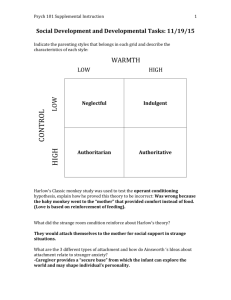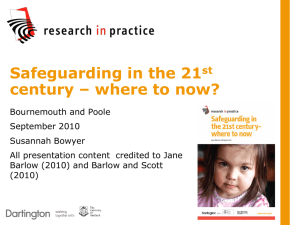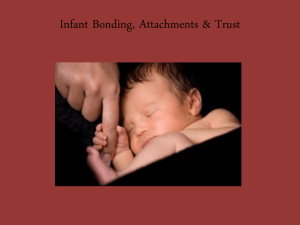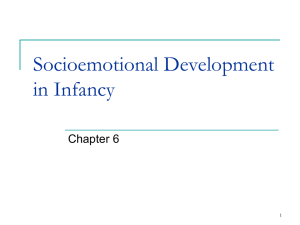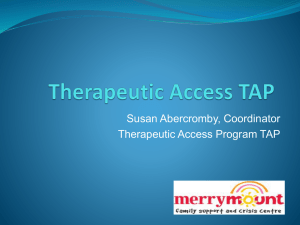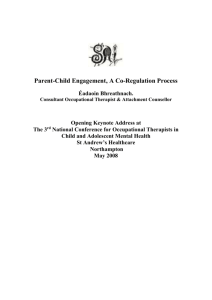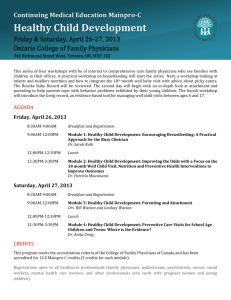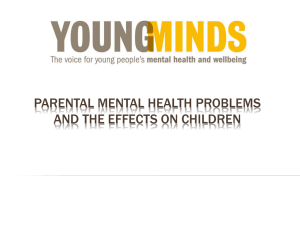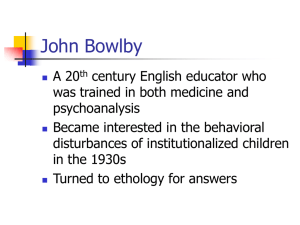Attachment and Infant Mental Health
advertisement
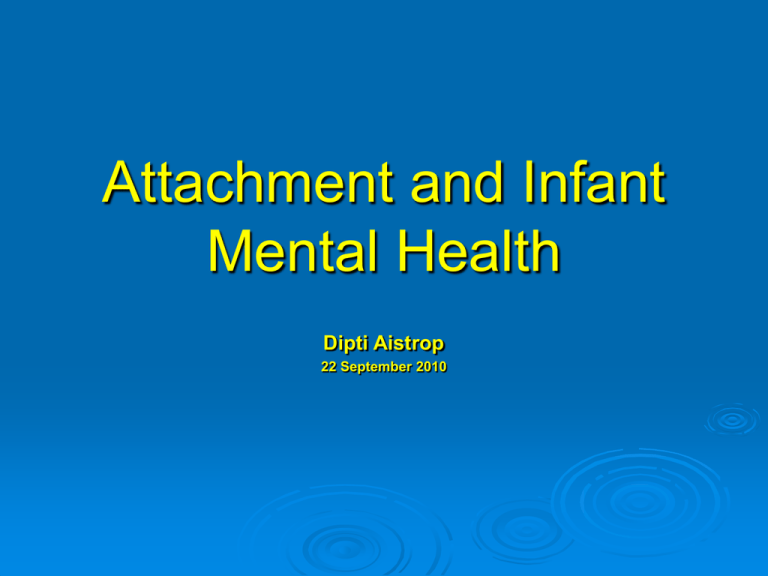
Attachment and Infant Mental Health Dipti Aistrop 22 September 2010 Definitions of mental health Importance of early years Mental health needs of babies Attachment and sensitive care giving Brain development in formative years Practice overview Health is the basis for a good quality of life and mental health is of over riding importance in this (UN Convention – Rights of the Child; Article24) Children who are mentally healthy will have the ability to develop psychologically, emotionally, creatively intellectually and spiritually.(Bright futures,Mental health foundation 1999) The Significance of infancy for mental health “Good parenting is fundamental for the development of a child's mental health and well being. As children's primary carers, all parents need to be supported and helped, but especially when they are parenting in difficult circumstances or facing uncertainty about the way they are bringing up their children. Interventions focused during pregnancy and at the time around the birth are likely to be the most effective in preventing mental health problems of a child. ……….” The Mental Health of Children and Young People: A Framework for Promotion, Prevention and Care, Scottish Executive, 2005. (1) Pre-natal / Early Years Babies thrive when they receive warm, responsive early care Early care has a decisive, long lasting impact on how people develop, their ability to learn, and their capacity to regulate their own emotions Babies need: To be nurtured Security Predictability Support Encouragement Development through expansion To feel loved Babies are born ready to communicate and relate to another human. They are ready to learn and to develop a relationship Attachment is the deep and long lasting connection that is established between a child and the primary care giver in the early years of a child’s life Quality of maternal sensitivity = determinant of baby’s attachment pattern Sensitive care giving (Video clip). When parents understand their baby’s communication, it enables them to reciprocate positively. ‘Attachment’ is the deep and long lasting emotional connection established between a child and care giver in the first years of life - a dyadic process Attachment is developed through reciprocity Reciprocity is a two way communication which enables the infant to form a concept of his own affect on his environment and on other people Babies are active in engaging their mother in a relationship, and through sensitive care giving, the mother and baby become attuned to each other. Secure attachment pattern enables a child to: Trust and reciprocate Learn to self regulate Develop self esteem and self worth Have a sense of right and wrong Develop empathy and compassion Develop resilience Have healthy brain development – achieve academic success Develop an ability to make and sustain relationships Insecure Attachment types: Attachment Disorder Insecure ambivalent Insecure avoidant Insecure anxious Disorganised Insecure attachment is more likely to lead to A negative internal working model Self perception: Unlovable Uninteresting Unvalued Ineffective The World: Others are unavailable Neglectful. rejecting Unresponsive Hostile Potential effects of insecure attachment: Feeding problems Sleep disturbance Toileting/gastric problems Aggression Poor concentration / attention span Lack of co-operation Longer term: fears and phobias associated with anxiety, emotional disorders, anti social behaviours, relationship difficulties…… Is attention seeking behaviour a manifestation of attachment seeking? Brain Development All behavioral development has to do with the brain Brain development is dependent upon both experience and genetics The brain has a great deal of plasticity and can recover over time. 5 Days 2 Months 1 Year 28 Years Early Experiences are Crucial By age 3, 80% of synaptic connections are already made By the second decade of life growth levels off and pruning begins Increased experiences define the wiring of an infant’s brain Brain development is not automatic but is 'experience dependent'. During the first three years of life, the brain makes trillions of new connections between nerve cells – known as synaptic growth. These connections govern the development of language, emotional, physical, social and cognitive abilities. Connections that have been repeatedly used grow stronger, form well-trodden pathways and are retained. Those connections that have not been used are 'pruned' and shed by the age of three, resulting in literally a smaller, less developed brain with fewer connections across which messages can be passed between nerve cells 6 Years Old 14 Years Old Nature vs. Nurture During the first 10 years of life the brain is twice as active as that of an adult’s 60% of nutrition is used by the brain during the first year of life. This decreases to 30% by age 3 Genetic and environmental factors have a more dynamic, qualitative interplay that can not be reduced to a simple equation Building Blocks for Secure Attachment & Positive Mental Health Reciprocity to infant communication and cues Resilience Parental mental health Temperament Impact of child on parents Parental sensitivity Sensitivity Responds to cues, reciprocates Insensitivity Intrusiveness – reflects parents own wishes/needs Acceptance Of responsibility with little or no irritation Rejection Displays feelings of anger or resentment and irritation Co-operation Respectful of child’s autonomy Interference Imposes own wishes and expectations Accessibility Familiar with child’s communication – will be easily distracted by the child Ignoring Pre occupied with own thoughts, often miss child’s communication but notice behaviour outcomes Factors that build resilience: Child • • • • • Temperament Secure attachment Communication skills Positivity in approach Ability to problem solve Family • • • • Four or fewer children in family At least one parent available for attachment Democratic parenting style Other significant adults Environment • Support networks in community • Availability of good housing • Easy access to services • Lack of poverty • Parental involvement with work/educational services Observation Criteria in assessing mental health of young children: Parent factors Child factors Environmental factors (video clip) Parent factors Poor parental mental health or post natal depression Overt family discord or domestic abuse Family breakdown/ bereavement Inconsistent, unclear boundaries with contradictory parenting styles Hostile or rejecting relationships Inability to adapt to child’s changing needs Parental substance / alcohol misuse Criminality in family Hostile or abusive parenting style Child factors Genetic make up Likelihood of learning difficulties or low IQ Chronic physical illness Developmental uncertainty or delay Communication difficulties Temperament Low self esteem / resilience Environmental factors Homelessness Poverty Discrimination Unemployment Difficult to access local services Communication between agencies Frequent moves to new areas What is needed to Develop a Seamless Service to Promote Mental Health Mid Wives School Health Universal Services Sure Start Child Centres Education GP Health Visitors Targeted Services Including Family Nurse Partnership Social Care Gaps ???? Family Support Resources tend to be re-active rather than proactive All parents wish to succeed at parenting What services are we to offer in order to ensure they get it right from the beginning? For better outcomes for babies and young children’s Mental Health, prevention is necessary - it is certainly better than cure. Thank you for listening.

